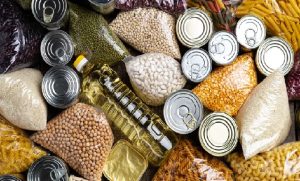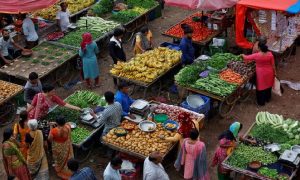27-11-2024
Bureau Report
NEW DELHI: India expects food inflation to slow in the coming months, backed by a bumper summer crop harvest, and remains “cautiously optimistic” on its economic growth, according to a government report.
“A bumper kharif (summer crop) harvest is expected to lower food inflation in the coming months,” the report said.
 India’s retail inflation surged to a 14-month high in October, driven by high vegetable prices.
India’s retail inflation surged to a 14-month high in October, driven by high vegetable prices.
A favorable monsoon, adequate reservoir levels and higher minimum support prices are likely to boost winter crop sowing and production, it said.
“Early November trends signaled moderation in key food prices, though geopolitical factors may continue to impact domestic inflation and supply chains,” it said.
The report said many high-frequency indicators of economic activity in India have shown a rebound in October after a brief period of softening momentum.
Persistently high inflation has squeezed India’s middle class budgets, slowing urban consumption in the last few months and threatening brisk economic growth. India expects the economy to grow at 6.5%-7% in the financial year that ends in March.
India’s export recovery may encounter challenges due to softening demand in developed markets, the report said, with trade in services sustaining momentum.
“Geopolitical developments and policy decisions of the next administration in the United States will determine the course of trade and capital flows,” it said.
India’s city dwellers are cutting spending on everything from cookies to fast food as persistently high inflation squeezes middle class budgets, threatening the country’s brisk economic growth.
Slowing urban spending over the past three to four months has not only hurt the earnings of largest consumer goods firms, it has raised questions about the structural nature of India’s long-term economic success.
 Since the end of the pandemic, India’s economic growth has been driven in large part by urban consumption, however, that now seems to be changing.
Since the end of the pandemic, India’s economic growth has been driven in large part by urban consumption, however, that now seems to be changing.
“There is a top end – the people with money are spending like that is going out of style,” Nestle India Chairman Suresh Narayanan said.
“There used to be a middle segment, which used to be the segment that most of us fast moving consumer goods (FMCG) firms used to operate in, which is the middle class of the country, that seems to be shrinking.”
Nestle India, which makes Kit Kats and other well-known goods, reported its first quarterly revenue drop since the COVID-hit June quarter in 2020.
While there is no officially defined income bracket for Indian middle class households, they are broadly estimated to account for a third of India’s 1.4 billion people.
They are considered a key demographic both economically and politically, with middle class frustration seen as a significant factor behind Prime Minister Narendra Modi’s weaker election performance this year.
Asia’s third-largest economy is expected to expand 7.2% in the financial year ending March 2025, the fastest among its major peers.
Belying those rosy projections, however, are signs of a sharp slowdown in the household sector.
Indian urban consumption hit a two-year low this month, according to an index published by Citibank that captures indicators such as airline bookings, fuel sales and wages.
“While some of the fall could be temporary, the key macro drivers remain unfavourable,” Citi’s chief India economist Samiran Chakraborty said.
 Pressmediaofindia
Pressmediaofindia




